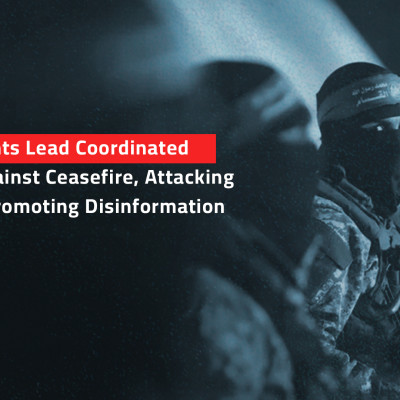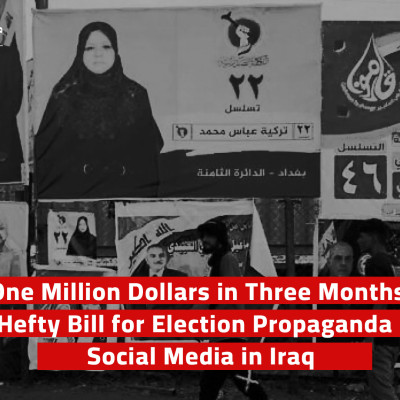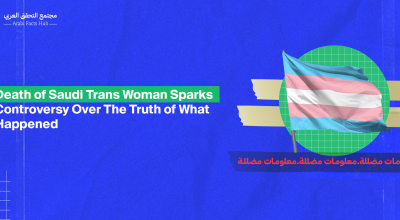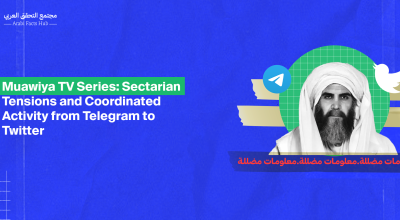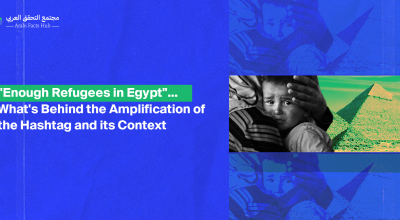Two Rival Accounts of Dr. Ban’s Demise: Online Armies Each Push Their Narrative

Ibrahim Hilal
The death of psychiatrist Ban Ziad became a major topic in Iraq's digital sphere after she was “found dead” in her Basra home on August 4, 2025. Her family attributed her death to suicide, citing "psychological pressure" as the cause and noting that she had cut her wrists. However, within hours, skepticism regarding the official cause of death started to grow.
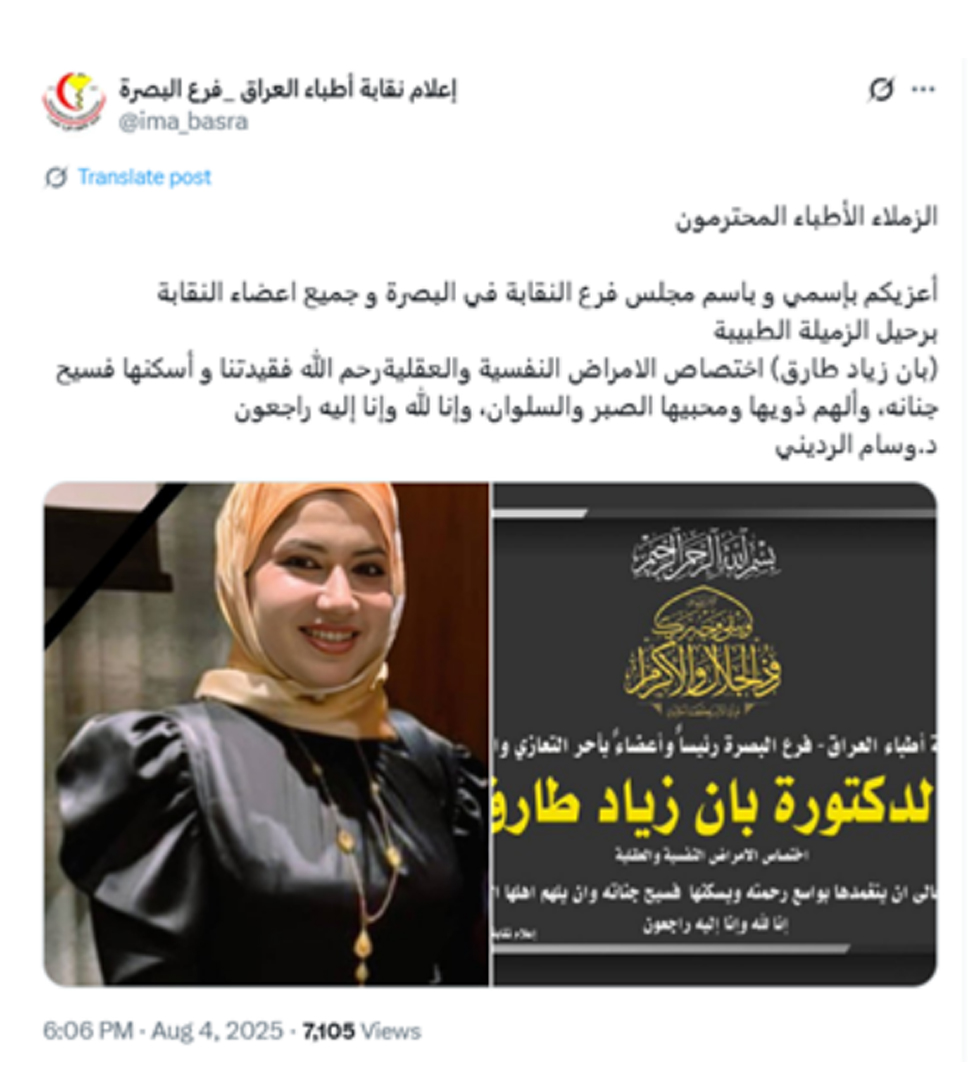
Some of the doctor’s colleagues, including Dr. Walid Katte’, confirmed that Dr. Ban had not suffered from any psychological disorders or problems that might drive her to end her life. Others went further, accusing certain family members of killing her—especially after reports circulated that bruises had been found on her body—fueling speculation of possible foul play.
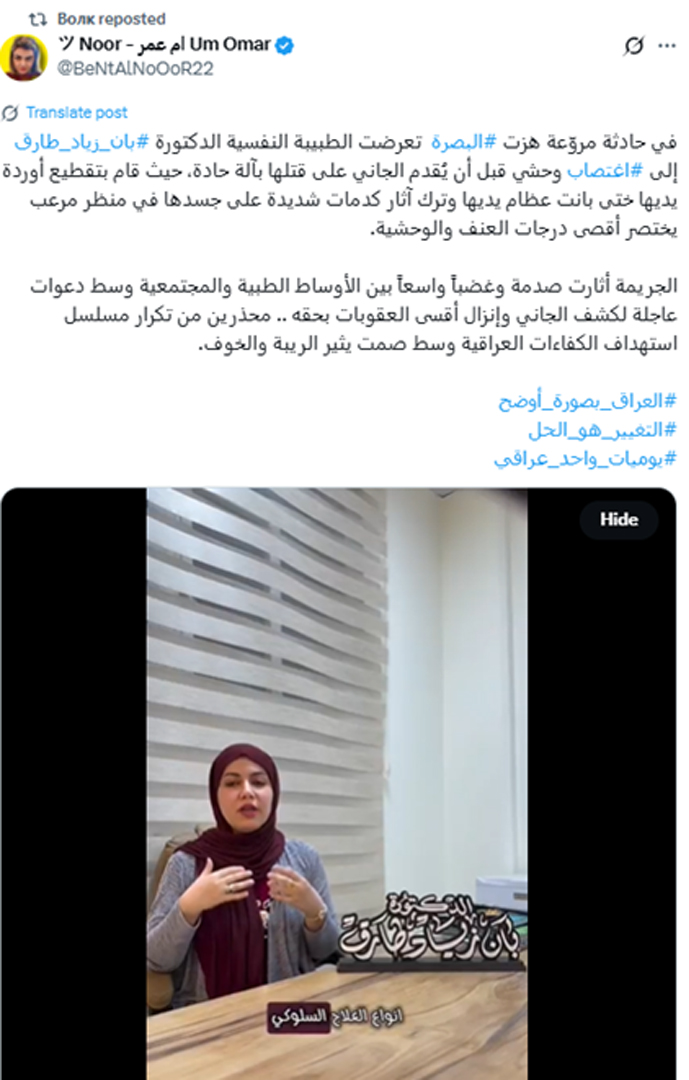
Amid growing public and media pressure, the authorities announced the launch of a wide-ranging investigation into the case. A judicial committee was formed, and the file was transferred to Baghdad for examination by the Department of Forensic Medicine and Criminal Evidence.
Member of Parliament Uday Awad shared “new” details regarding the mysterious death of Dr. Ban, pointing to six observations that raised suspicion. These included the deliberate disabling of surveillance cameras before, during, and after the incident, despite no technical malfunction being detected; the presence of marks around the neck suggesting strangulation; and the absence of any rope or other tool used for that purpose when the crime scene was examined by forensic experts.
He also noted delays in reporting the incident by the victim’s family and that they cleaned the scene immediately after the body was moved, without authorization from the authorities. Furthermore, bruises were found on various parts of the body, along with two symmetrical wounds on both hands—each about nine centimeters long, six centimeters wide, and deep enough to reach the bone, positioned lengthwise—despite the victim being left-handed. The sharp object that caused the wounds was not found at the scene.
Additionally, the phrase “I want God” was written on the bathroom wall in the victim’s blood, in thick letters approximately three centimeters wide, with each letter requiring a substantial amount of blood to complete.
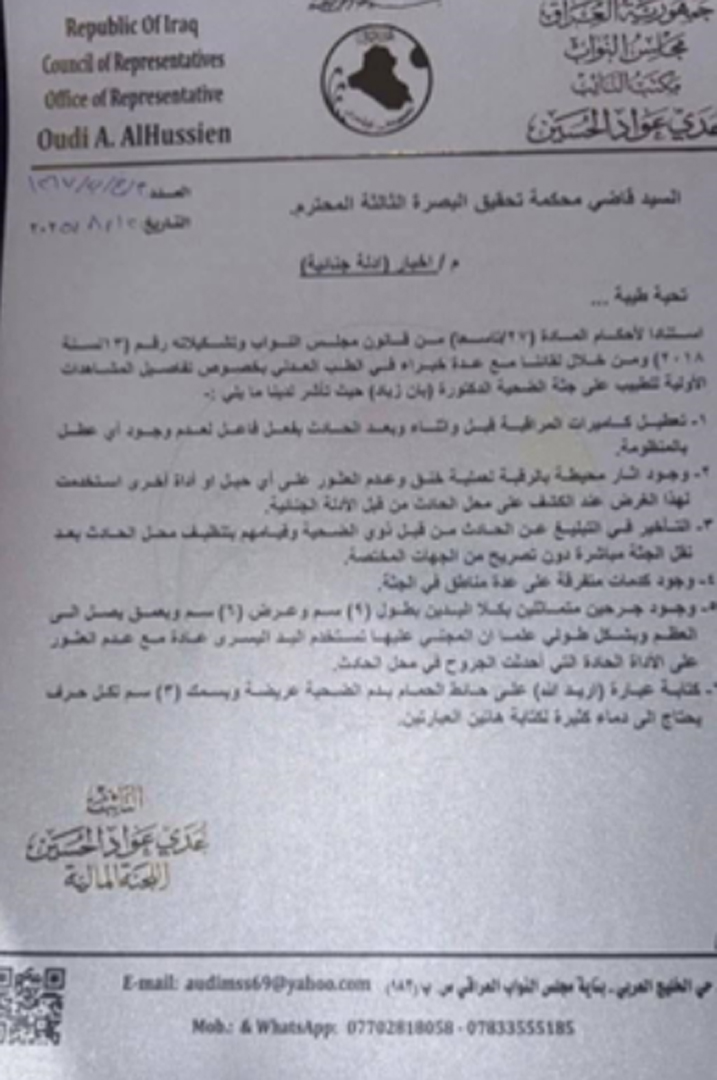
But on August 18, 2025, the Supreme Judicial Council announced that the Presidency of the Basra Court of Appeal had sent to the Council’s office the official decision regarding the death of Dr. Ban Ziad, which, according to its findings, concluded that the incident was a suicide, and therefore the investigation was closed.
Medical reports indicated that the doctor had been suffering from chronic depression, diagnosed by specialized psychiatrists in Baghdad. She had been receiving treatment with Bupropion, a medication known for its effectiveness in treating depression. However, doctors had warned that irregular use of the medication or succumbing to negative thoughts could lead to suicidal tendencies.
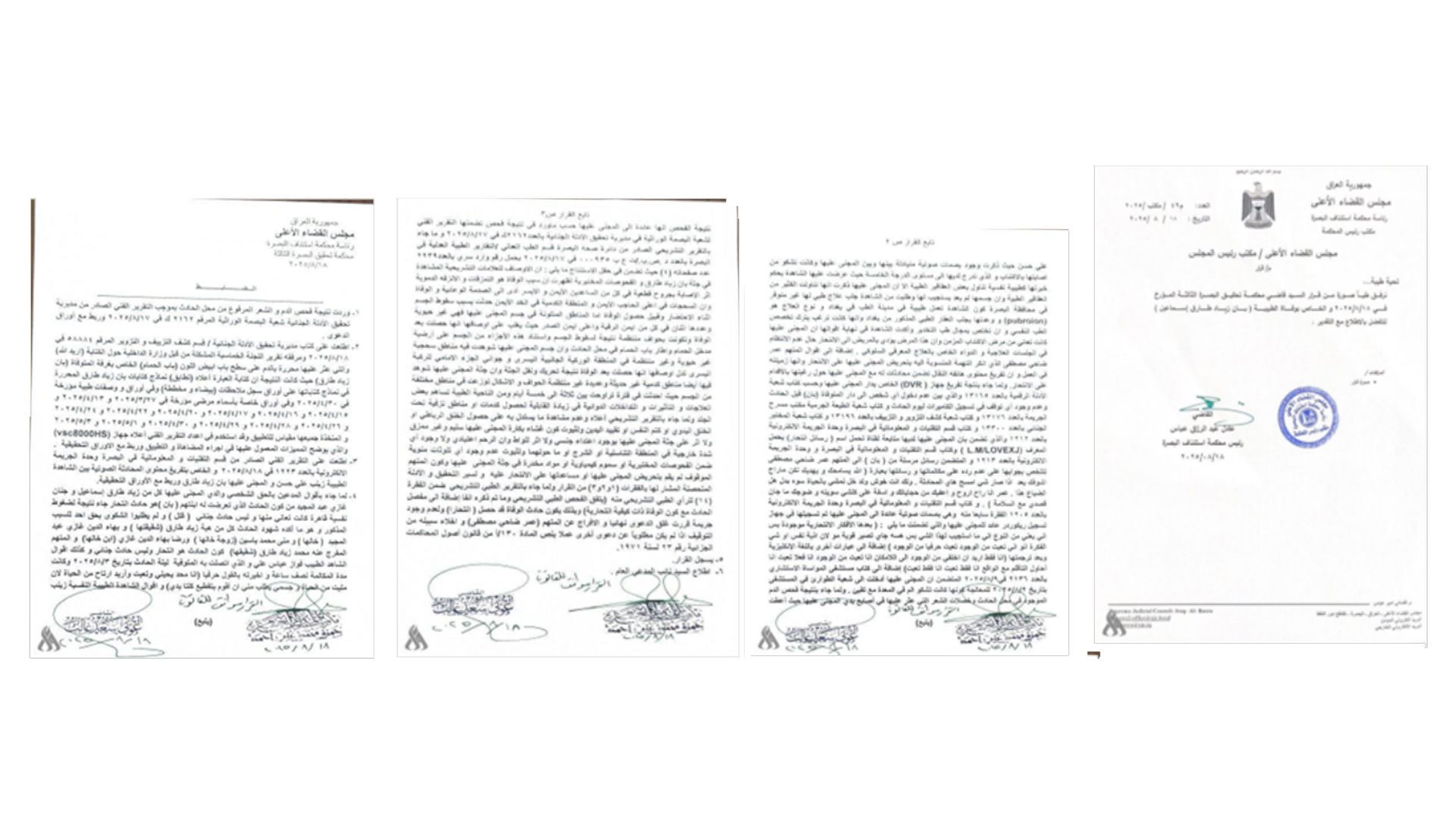
The case did not end there. Suspicion and speculation surrounding the doctor’s death spread across all social media platforms, turning the death of Dr. Ban Ziad into a public opinion issue that captured the attention of Iraqis and others following the case closely.
Murder vs. Suicide Narratives
Two competing narratives emerged around the incident. The first, promoted by the doctor’s family and confirmed by the judiciary, asserted that she had committed suicide. The second, driven by some of her colleagues who denied that she suffered from depression or would take her own life, claimed that she had been murdered — a narrative widely embraced by social media users through hashtags such as #بان_لم_تنتحر_بان_قتلت (Ban Did Not Commit Suicide—Ban Was Murdered) and #بان_ليست_انتحار (Ban’s Death Was Not Suicide).
Posts discussing Dr. Ban Ziad Tariq began on August 4, 2025, when the account “Iraqi Doctors Syndicate – Basra Branch Media” shared a death notice for the doctor at 6:00 p.m. Just hours later, other accounts began circulating claims suggesting signs of torture and foul play in her death.
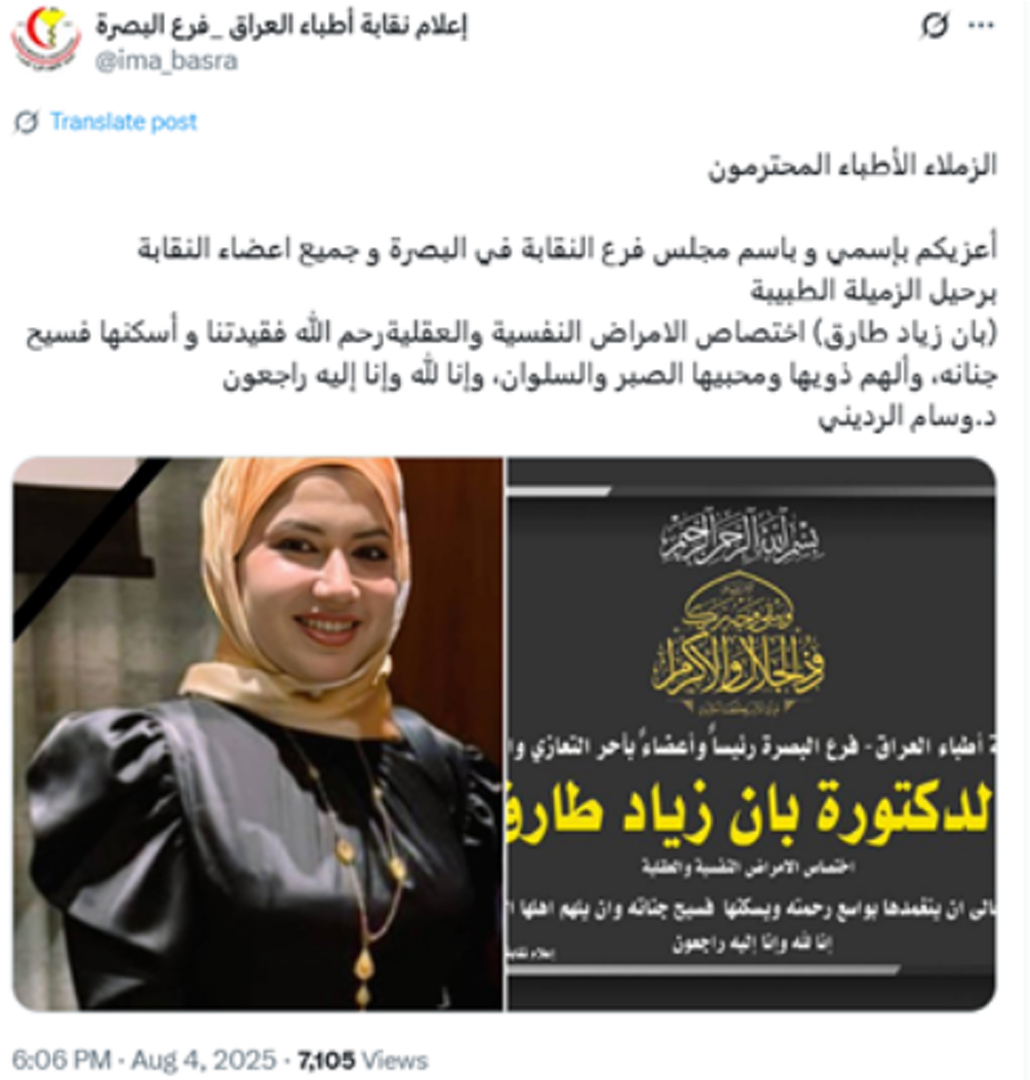
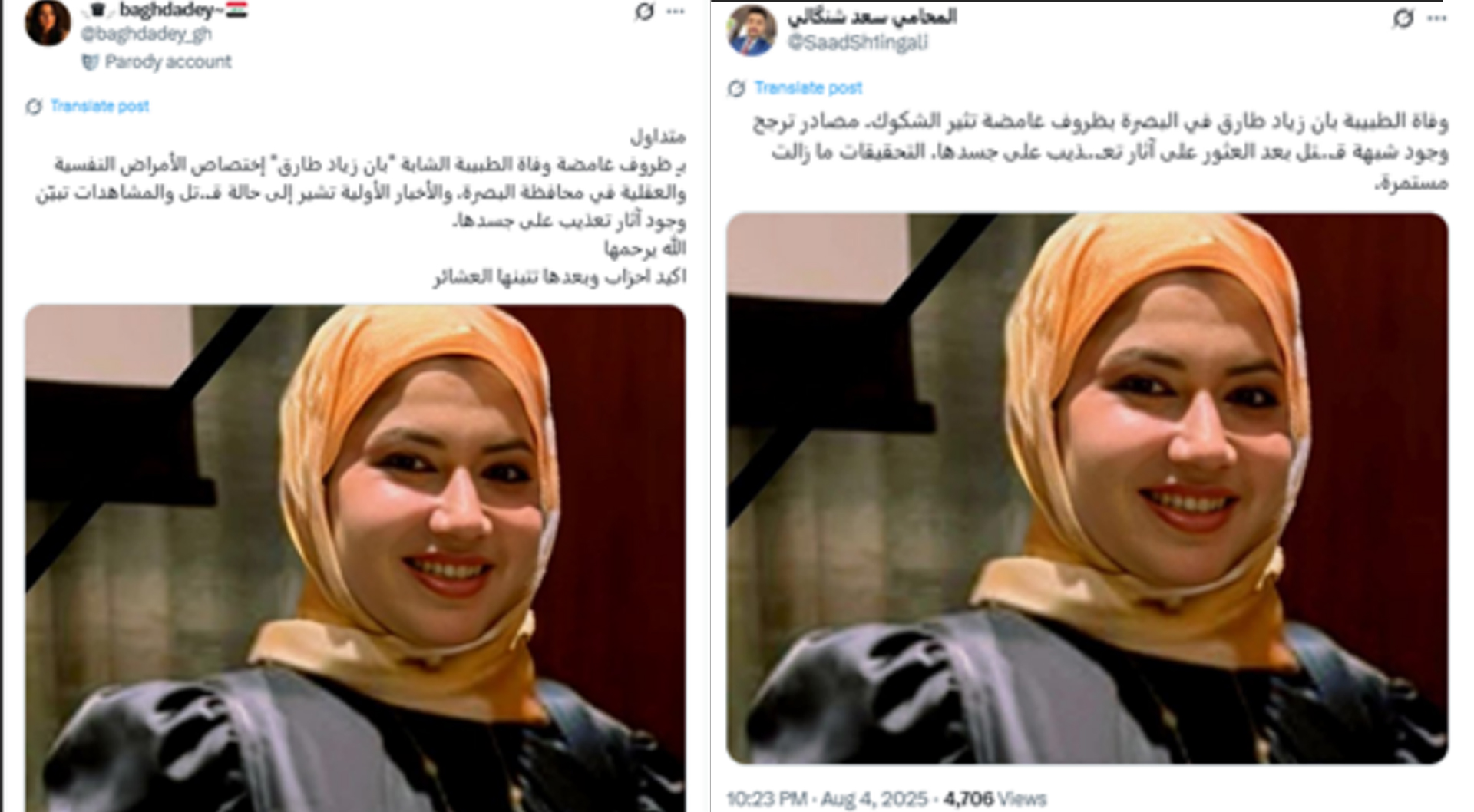
The following day marked the first appearance of the hashtag #بان_زياد_طارق (Ban Ziad Tariq), when an account named “ahmad (@4rther1)” retweeted a post by Zeina Al-Mashhadani, in which she claimed that Dr. Ban had been “killed in cold blood.” The account @4rther1 is known for its intensive activity against Shia factions in Iraq.
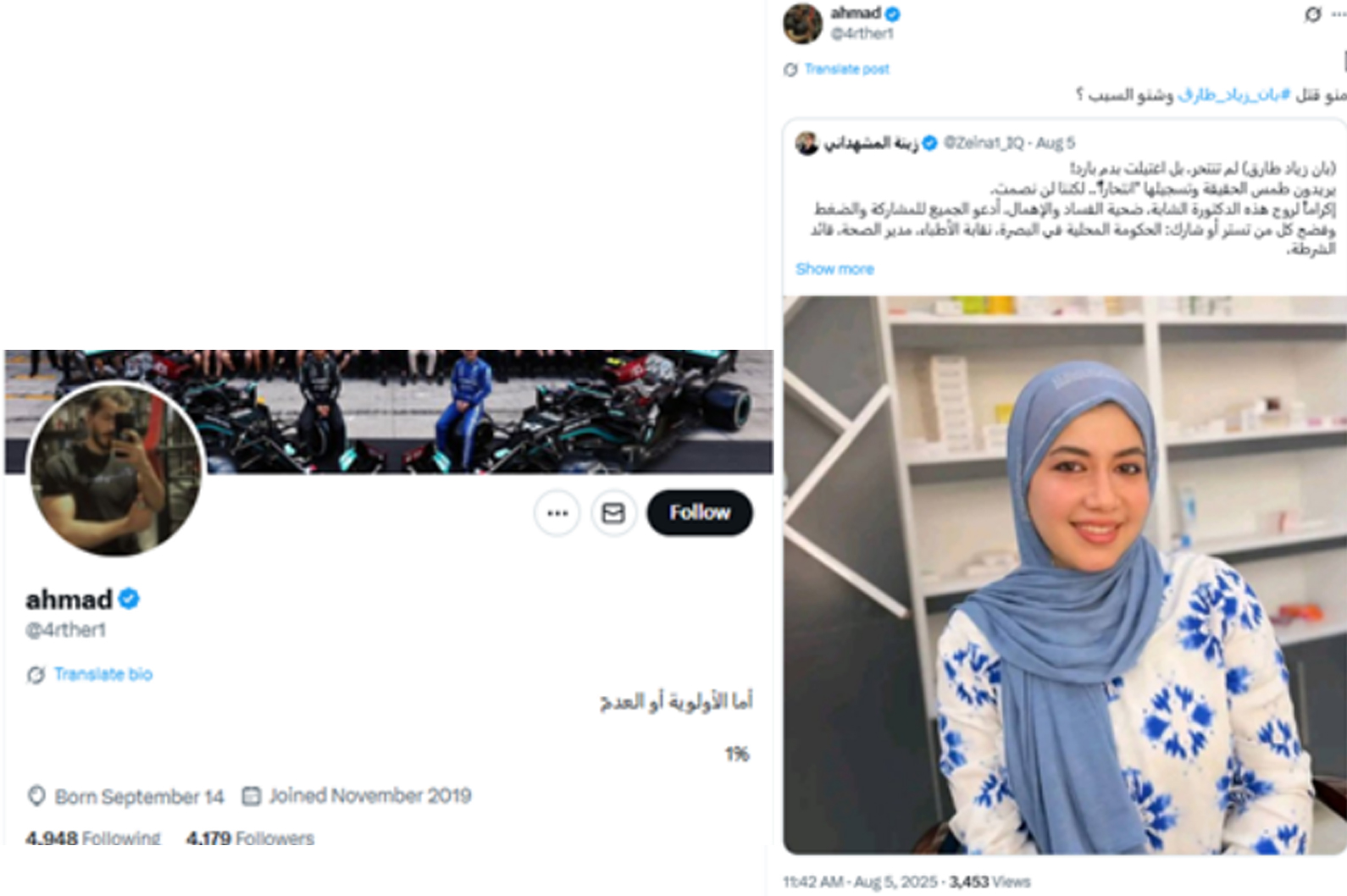
On August 7, "Eishaniq" published statements from Dr. Ban's mother, confirming her suicide due to psychological pressure.

However, the debate did not end with the statements of the doctor's mother and her family. On August 10, the hashtag "#بان_زياد_طارق_قضية_رأي_عام" (Ban Ziad Tariq: A Public Opinion Case) appeared for the first time in a comment written by a newly created account, named "noone @Tety31859218088". After examining the account, it was found that it had only published posts about Dr. Bann's case, as if it had been created specifically for this purpose.
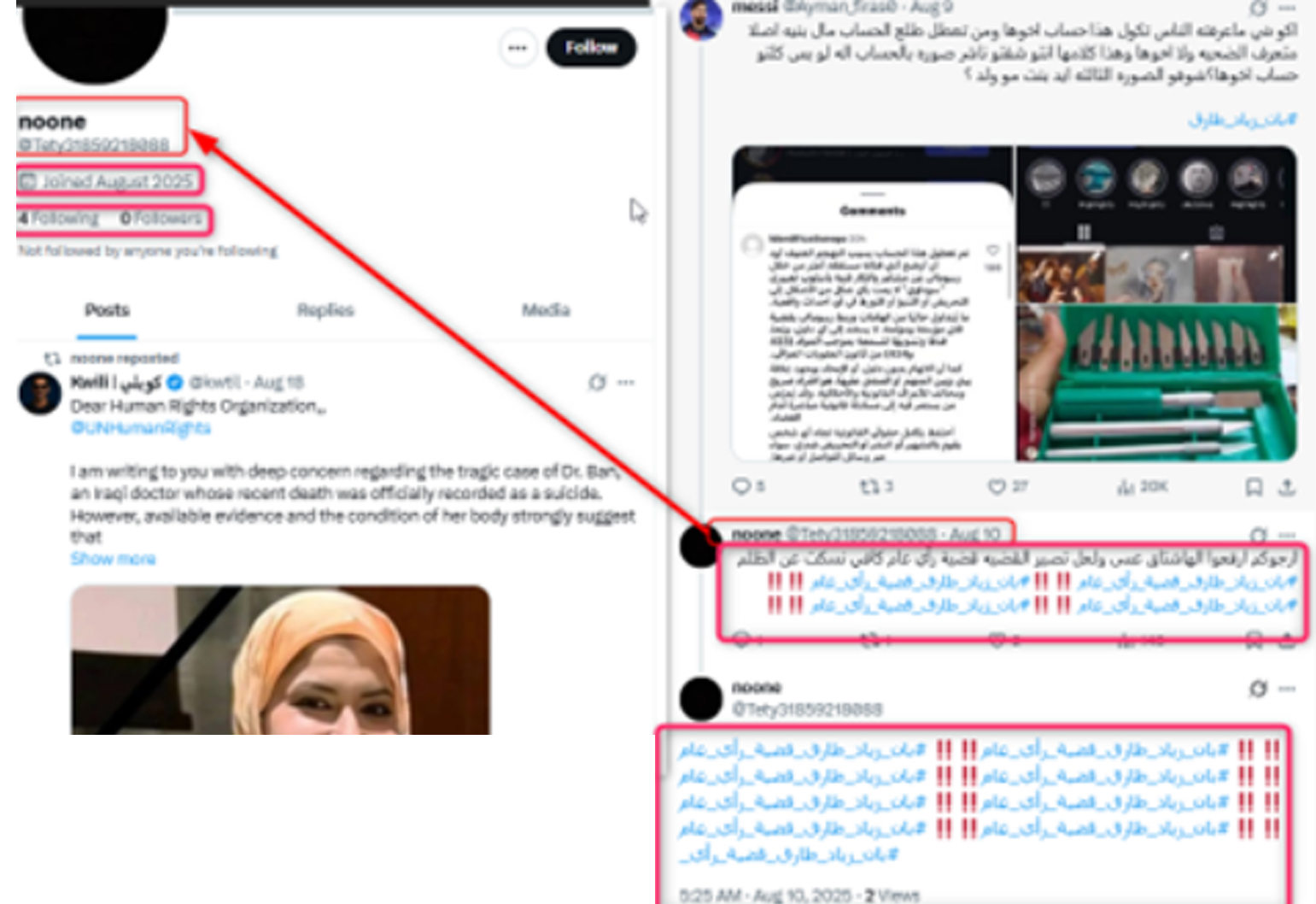
On August 12 — the same day Member of Parliament Adi Awad presented his document outlining potential evidence of a criminal suspicion surrounding the doctor’s death — the hashtag #بان_ليست_انتحار (BanIs Not Suicide) appeared on a page called “Raghad Al Asadi for Feminism,” an account created in 2024. The post was commented on by another newly created account named “Zainab Adnan @Zainabadna32405,” which mainly focuses on sharing news.
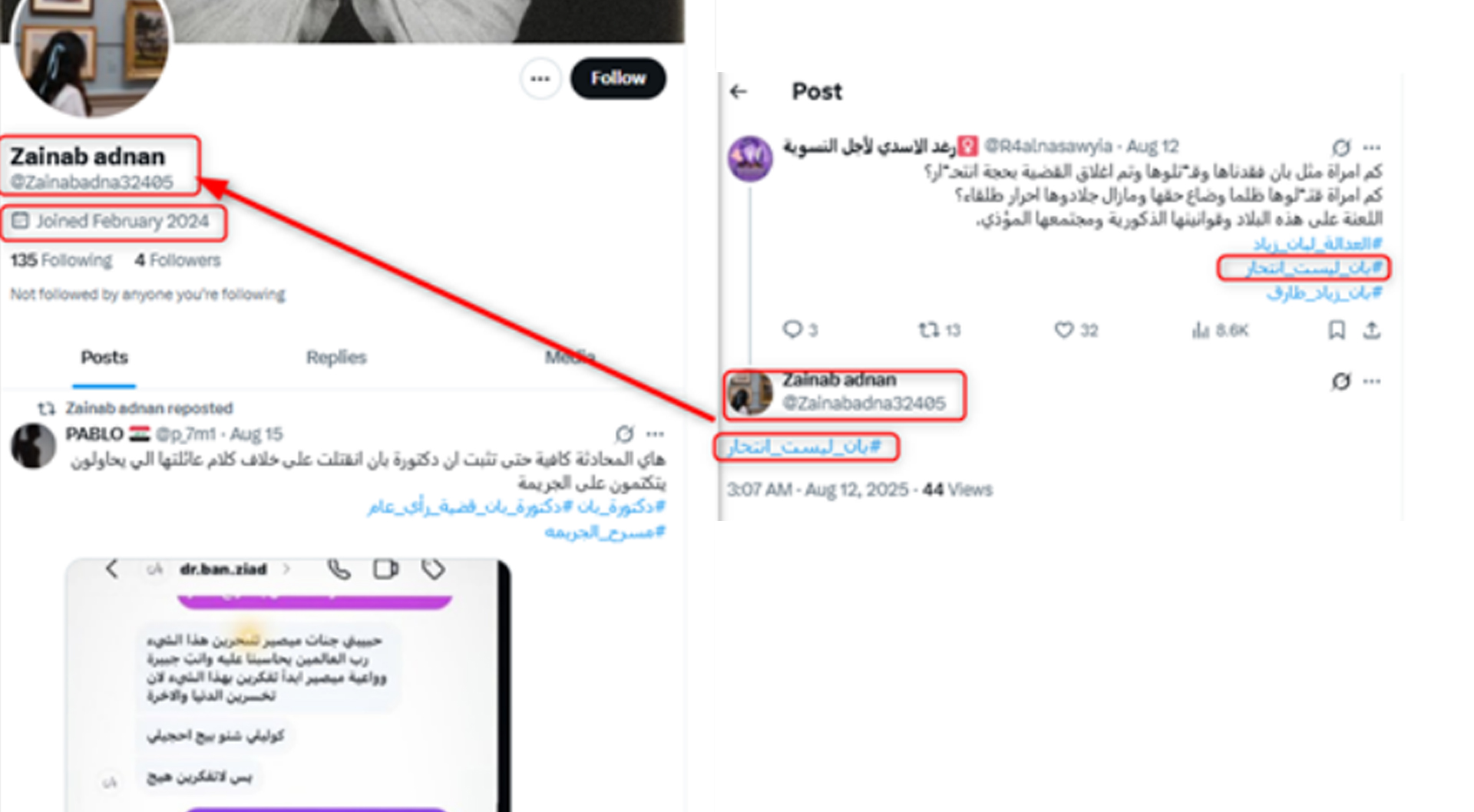
Since August 12, 2025, posting about Ban’s case began to intensify. We tracked all related posts using hashtags such as #بان_قضية_رأي_عام (Ban: A Public Opinion Case), #بان_زياد_طارق_قضية_رأي_عام (Ban Ziad Tariq: Public Opinion Case), #بان_زياد_طارق (Ban Ziad Tariq), #بان_ليست_انتحار (Ban Is Not Suicide), and #بان_لم_تنتحر_بان_قتلت (Ban Did Not Commit Suicide Ban Was Murdered).
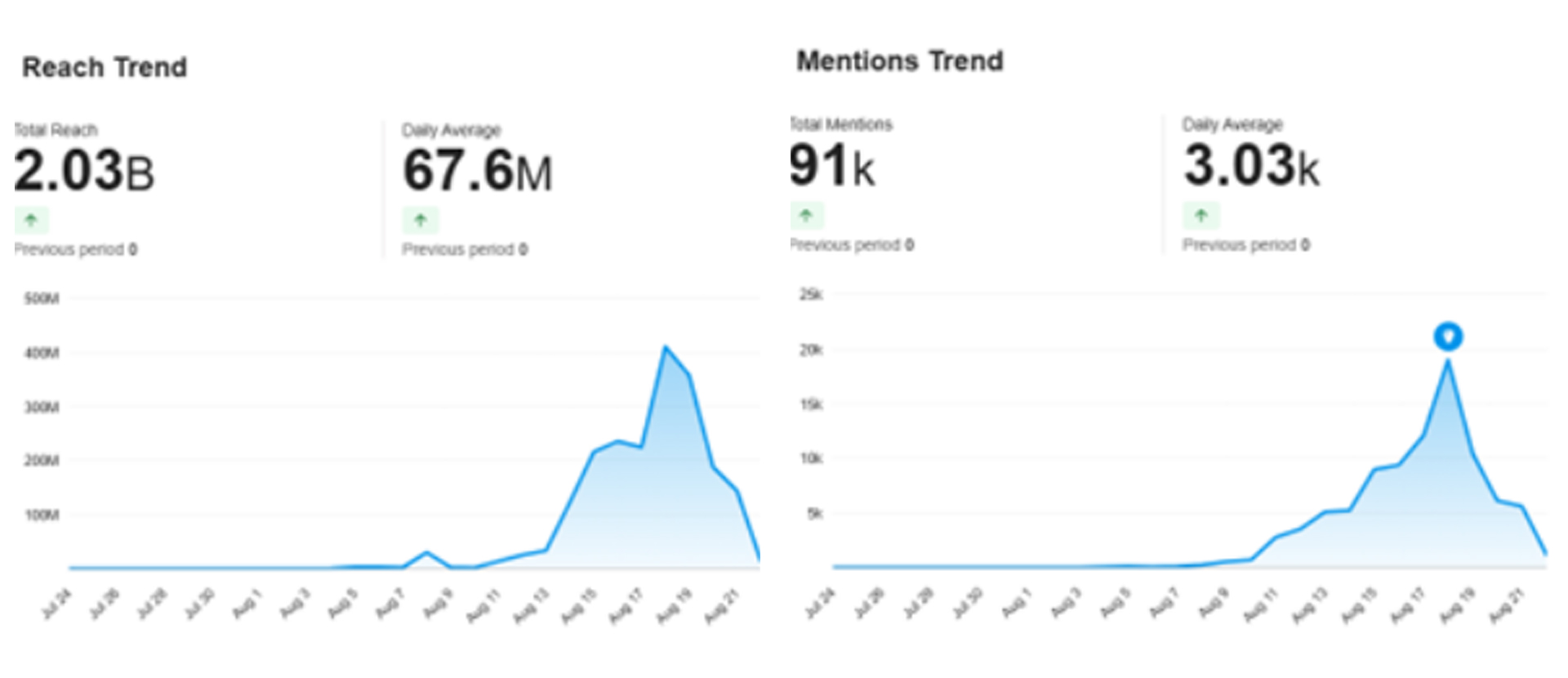
From August 4 to 22, the doctor was mentioned in 91,000 posts. These posts, comments, shares, and quotes were estimated to have reached approximately two billion views, averaging 67 million daily.
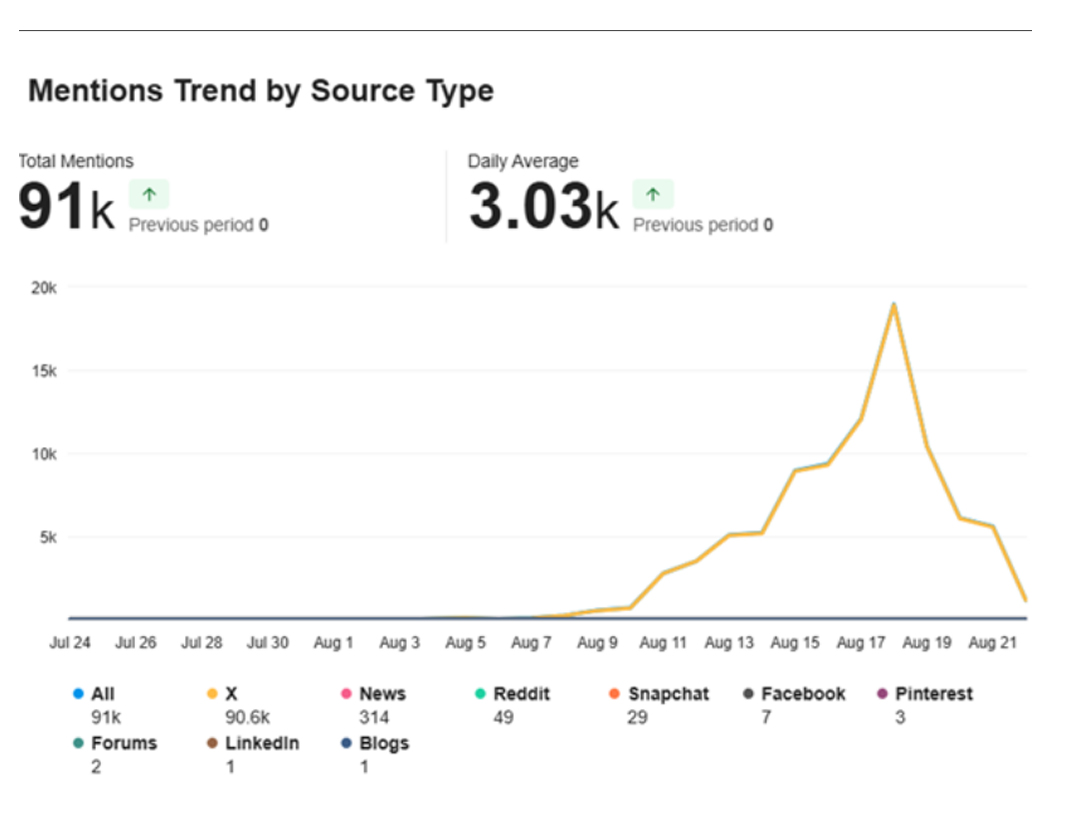
The posting campaign reached its peak on August 18, the day the Iraqi judiciary announced that the case had been closed as a suicide, which was rejected by social media users, who insisted that it was a deliberate murder.
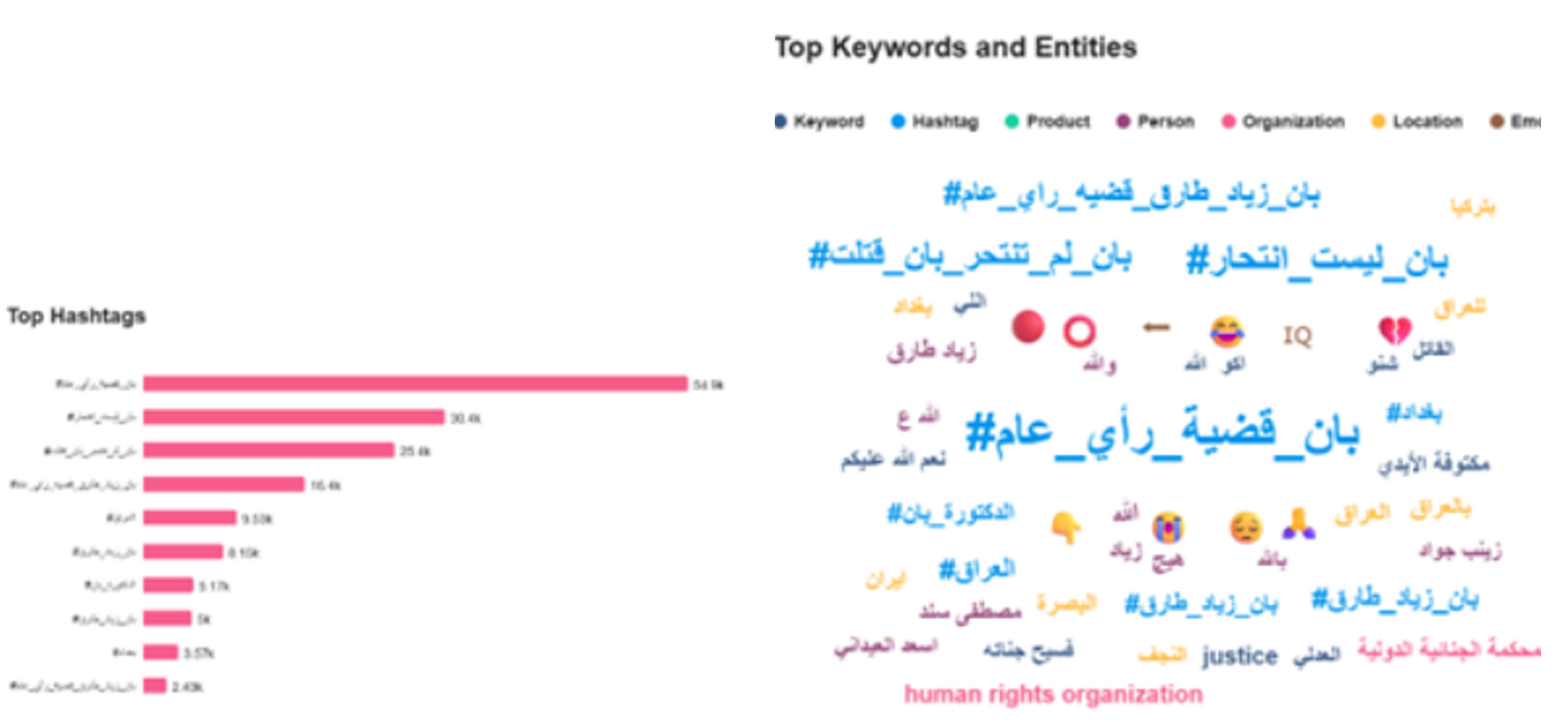
The hashtags #بان_قضية_رأي_عام (Ban: Public Opinion Case), #بان_ليست_انتحار (Ban Is Not Suicide), and #بان_لم_تنتحر_بان_قتلت (Ban Did Not Commit Suicide Ban Was Murdered) were the most prominent in both the word cloud and the list of most frequently appearing hashtags. Approximately 75 percent of the posts conveyed sadness, using both Arabic and English terms that explicitly suggested the commission of a crime and the absence of justice.
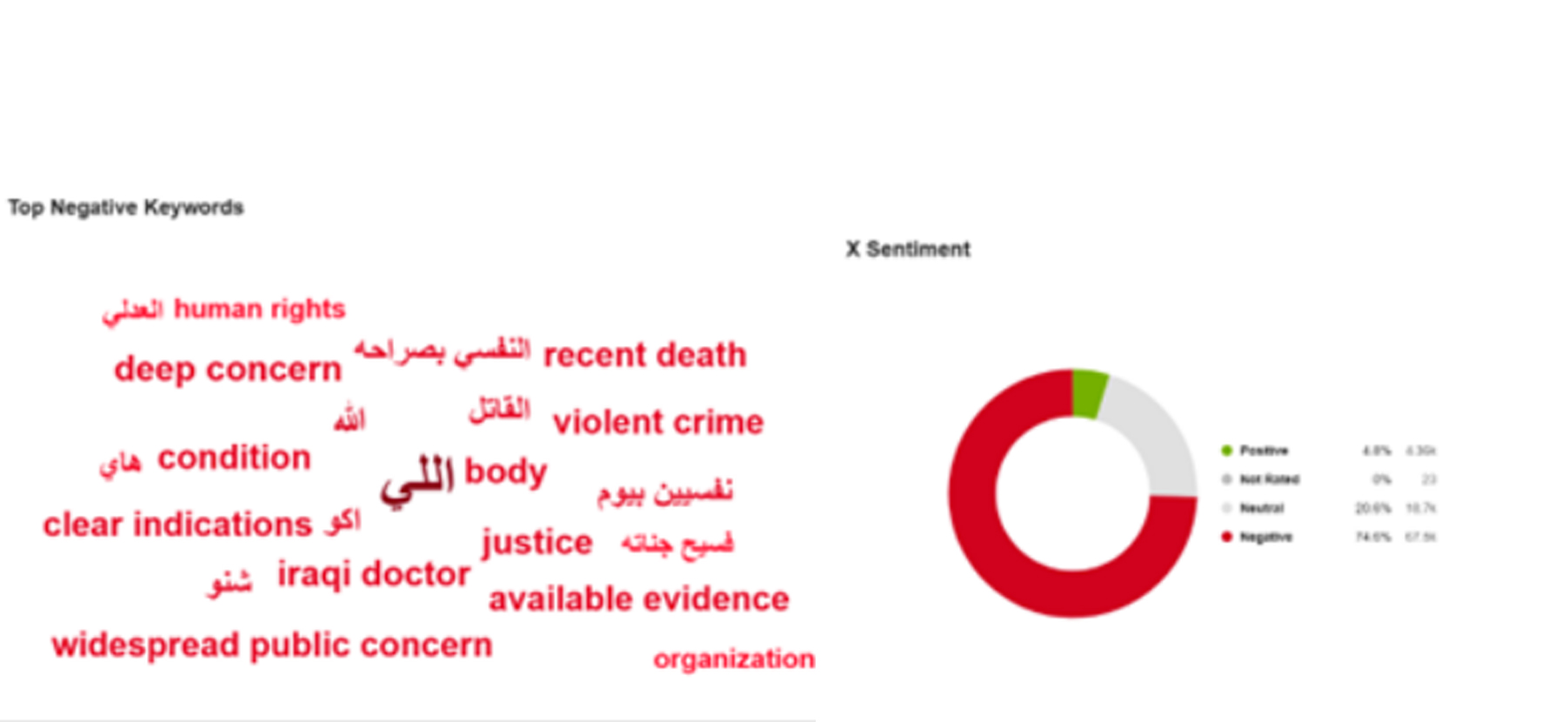
Whereas original content did not exceed 14% of total posts on X, the remaining content was divided between retweets and quote posts at 44%, while comments represented 42.5% of total posts. This indicates the conversation or debate is likely an amplification campaign.
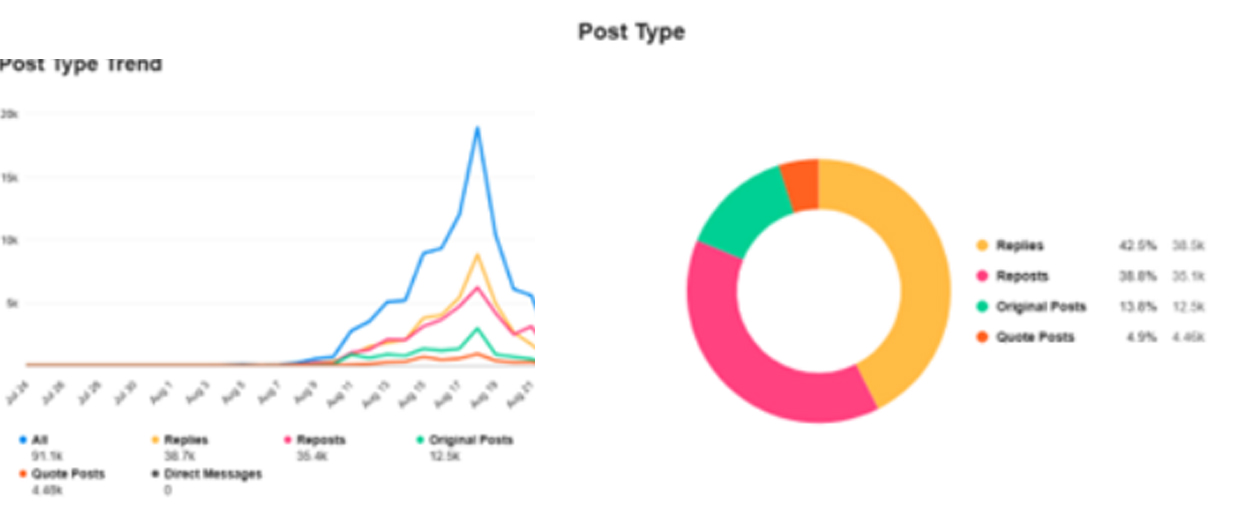
As the controversy over Dr. Ban’s case escalated on social media — despite the judiciary’s closure of the case and its classification as a suicide — a new trajectory emerged in the ongoing discussions. With increasing insinuations of whether the doctor’s death was an “honor killing” or a suicide triggered by “loss of virginity,” the accounts supporting the murder narrative began rejecting these implications.
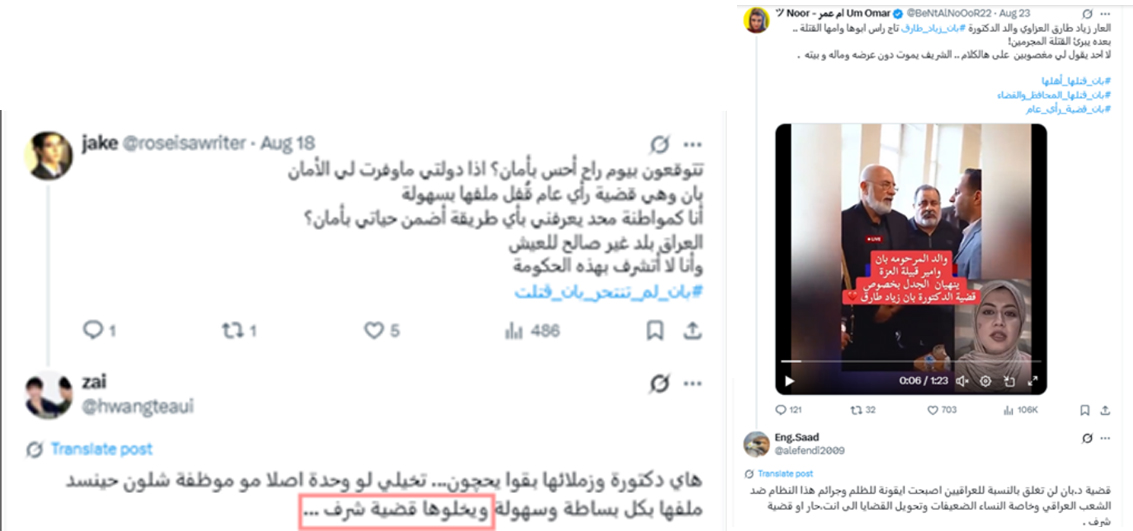
On the other hand, some accounts tried to justify the murder as an “honor killing” including the @David_Syriac account, which turned out to be an Iraqi account supporting Israel.
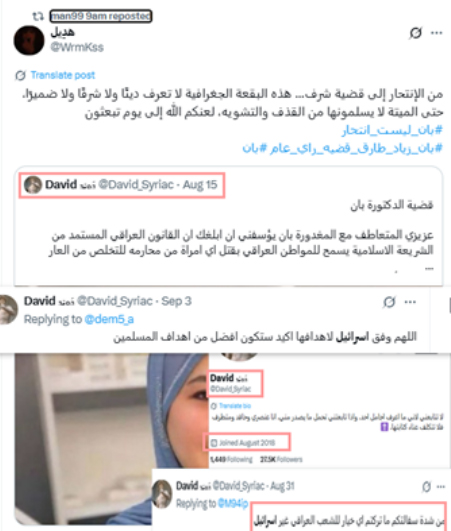
Iraqi MP Mustafa Jabbar Sanad promoted a narrative describing the incident as an "honor crime," or as he called it, "a private family matter."
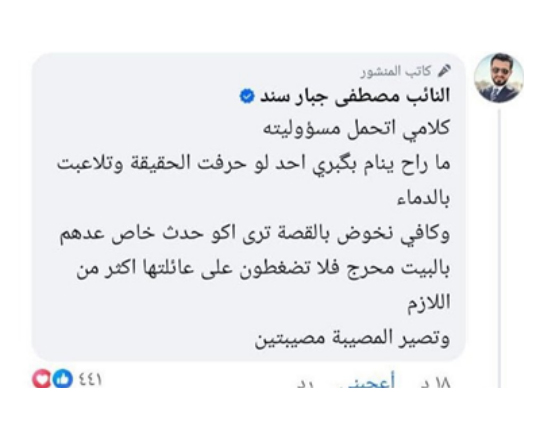
Narratives and the Most Interactive Accounts in the Campaign
An analysis of 20,000 randomly sampled posts using Meltwater revealed that three-quarters of the posts discussing Dr. Ban's death, whether as murder or suicide, were charged with anger and rejection. These posts largely framed the incident as a murder, contrasting with the family's claim of suicide. This framing shifted the narrative from a personal tragedy to a public issue intertwined with Iraq's political landscape.
In contrast, the presence of the other narrative—the official one endorsed by the doctor’s mother, family, and confirmed by the Iraqi judiciary, which ruled the death a suicide—was notably weaker. A few accounts published condolence posts and prayers for mercy while reaffirming trust in the Iraqi judicial system.
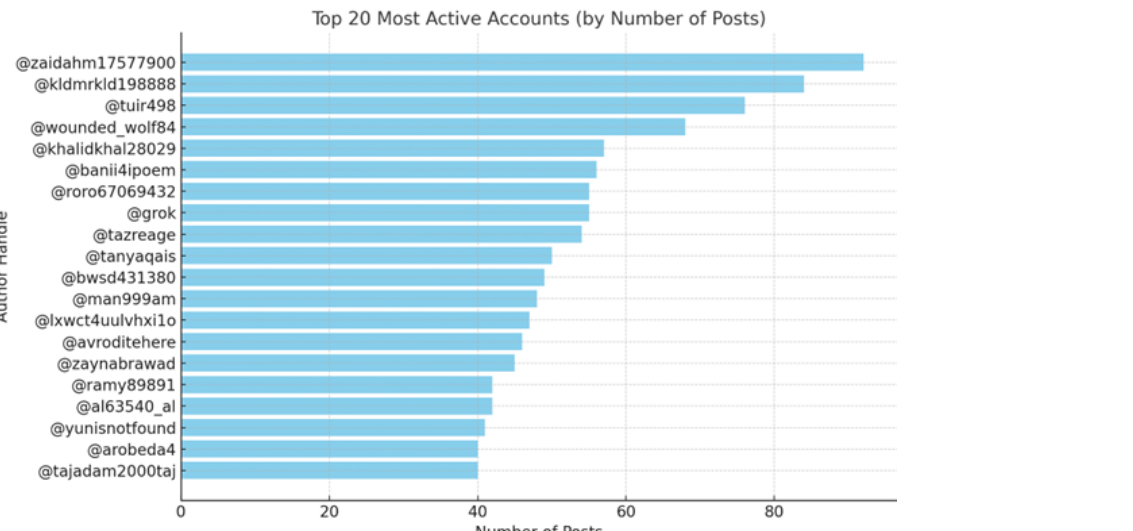
Data analysis revealed that many of the accounts most active in promoting the murder narrative were fake. By analyzing the dataset, we obtained a list of the most interactive accounts, topped by “Zaid Ahmed @ZaidAhm17577900,” an account that appears to be Iraqi, has very few followers, and uses a username containing random numbers—an indicator that it is likely a fake account.
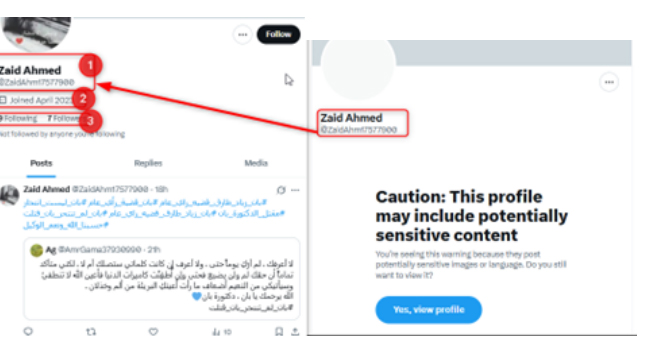
To verify this, we analyzed the posting times of the account and found that it had published 92 posts related to the doctor’s case. Posting time analysis showed that the account was active from 3 a.m. until midnight—essentially active throughout the entire day. This indicates abnormal activity. The account also posted multiple times at very short intervals, suggesting that it is likely a fake account or, at the very least, one that uses an automated scheduling tool for posting.
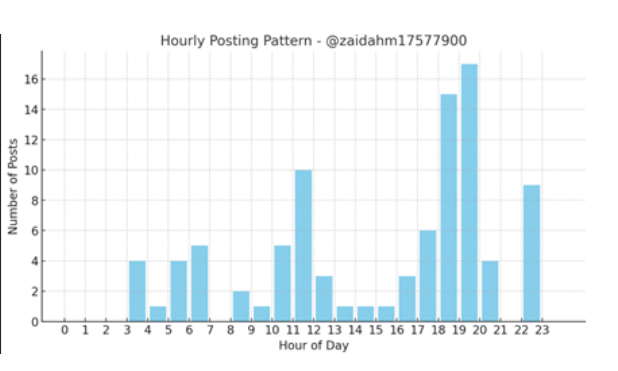
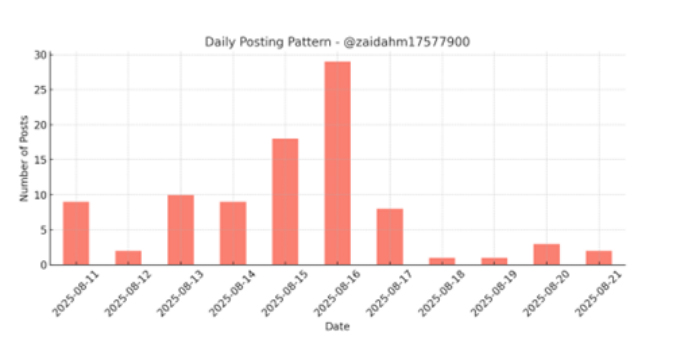
The account "Khalid Omar Khalid @kldmrkld198888" also appeared on the list. This recently created Iraqi account, established in 2025, similarly features random numbers in its username. It functions impersonally, solely engaging with news and refraining from publishing any personal posts.
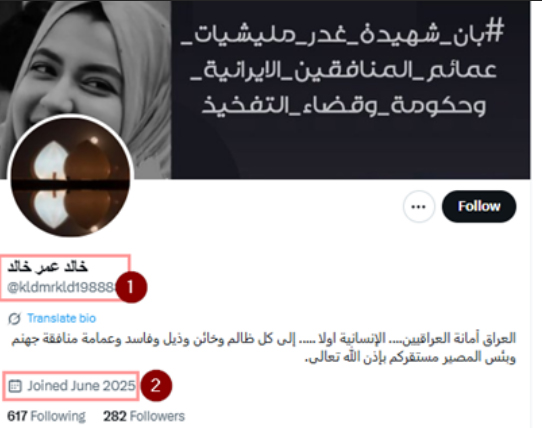
An analysis of the account's posting patterns revealed non-human behavior, with 84 posts published throughout the day. The account also posts regularly every day, with time differences approaching zero, indicating that it is fake.
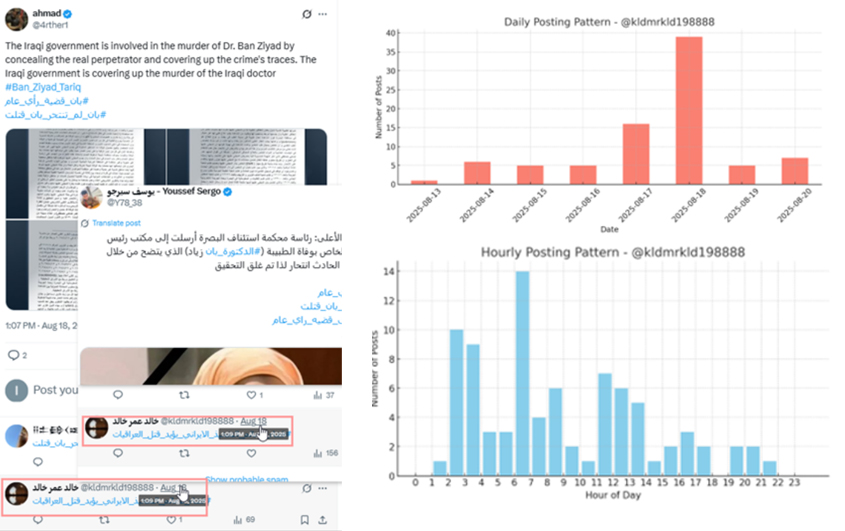
In third place was the Iraqi account "M/Sin | 🇮🇶🔻@Tuir498," which appeared in 2021. This account reposted a video claiming there were attempts to burn Dr. Ban's body, for which we found no evidence.
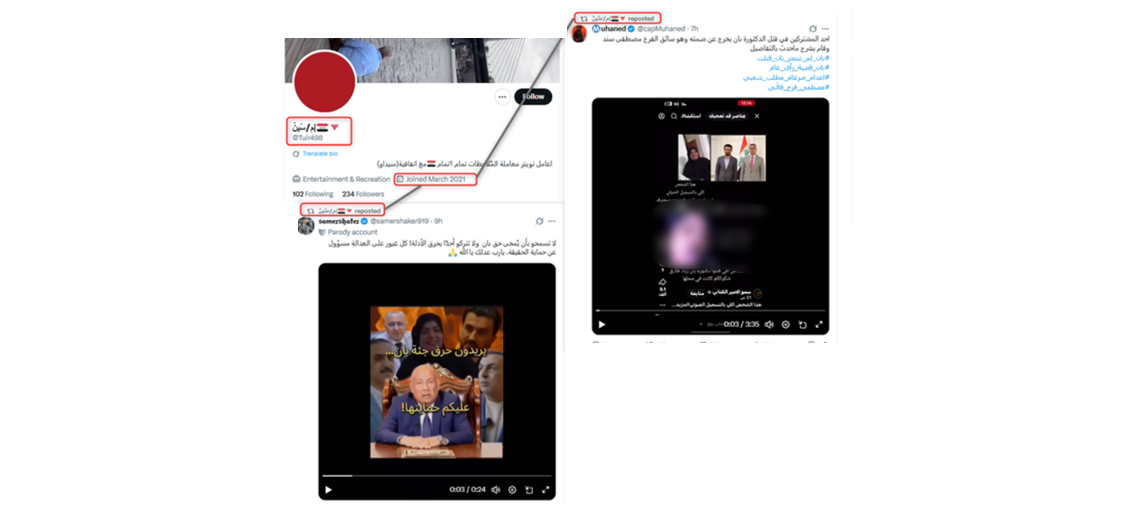
The account also shared a video clip whose uploader claimed contained an audio recording of “one of the participants in the murder of the doctor.” However, no evidence supports the authenticity of this alleged confession. A spectral analysis of the audio revealed the use of a voice mask or tone modification, and the analytical model we employed detected a sudden change in energy levels compared to the natural curve of the audio spectrum.
These changes appeared as sharp spikes in signal strength, suggesting that the audio file had been edited (cut). Such anomalies were observed between the 12th second and the 3rd minute of the recording.
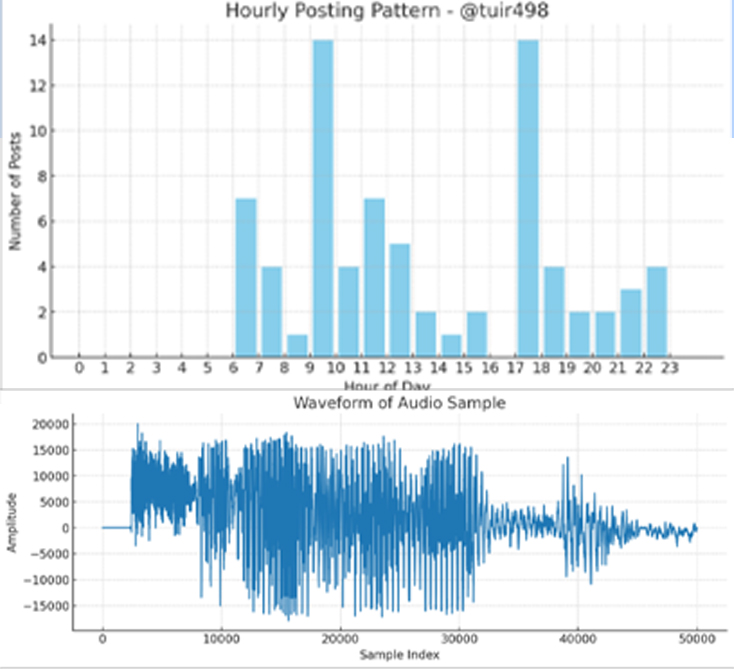
Upon analyzing the account's posting times, it became clear that the account, like its predecessors, is abnormally active and in an inhuman way. The account published around 76 posts in short intervals, which suggests that the account is fake, or at least uses a program to schedule accounts.
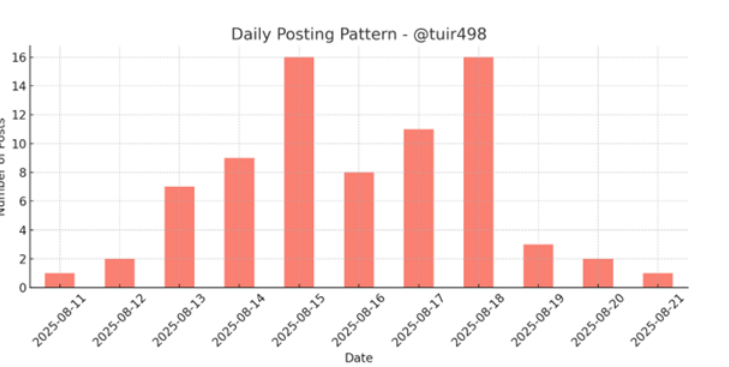
The account "Волк@Wounded_Wolf84," created in 2023 and based in Moscow, holds the fourth rank. This account twice re-shared an audio clip, which some allege contains "the confession of a participant in the killing of the doctor."
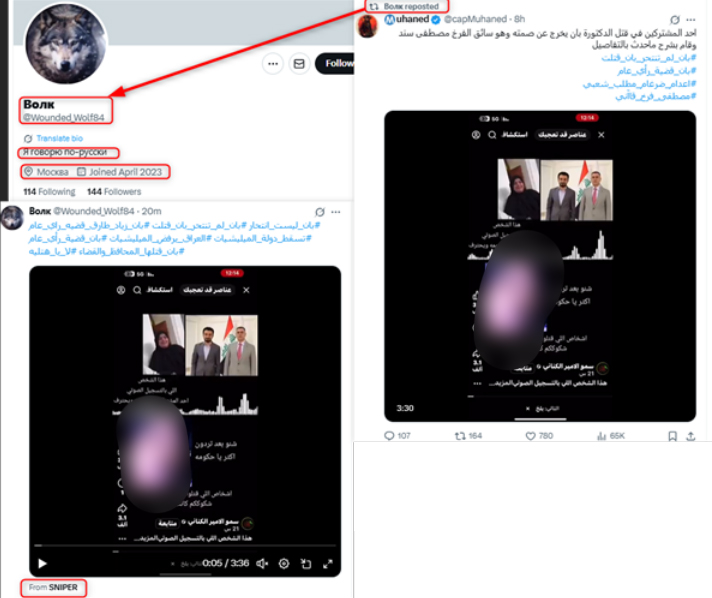
An analysis of the account's posting times revealed that, like the previous accounts, it follows an inhuman posting pattern. It published 68 posts distributed throughout all hours of the day at short intervals, less than two minutes, which indicates that it at least uses a program to schedule posts.
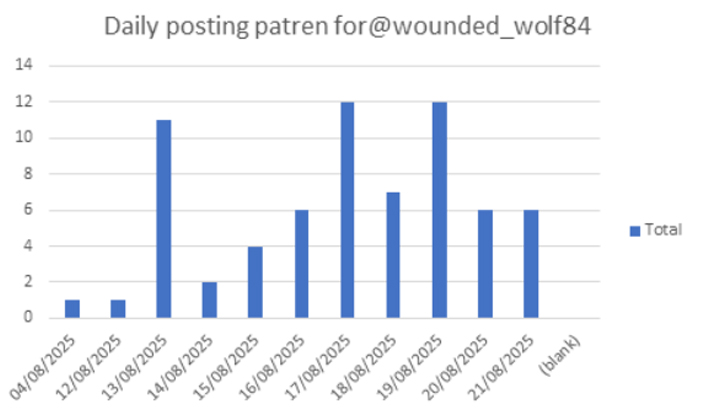
Coming in fifth was the account "khalid khalid @khalidkhal28029", an account created in 2023, which did not differ much from the previous accounts.

An analysis of the account's posting pattern revealed that it published 57 posts, distributed throughout all days of the campaign. However, like its predecessors, the account posts at all hours of the day, meaning it is non-human. The account also posts regularly and at short intervals (less than two minutes), which indicates that it is an automated account.

Our analyses indicate that the accounts involved in the campaign concerning Dr. Ban's death shared several things in common. Most notably, the accounts that showed the highest levels of interaction and posting activity were fake or automated. Additionally, nearly all of them were opposition accounts critical of the current government in Baghdad, frequently expressing hostility toward Shiite factions and their ties to Iran.
On the other hand, a number of accounts promoted an alternative narrative suggesting that the incident was an “honor killing.” Alongside MP Mustafa Sanad’s account and "@David_Syriac," a comment from an account named "Alaa Ahmed (@al3aa_6)"— a recently created Iraqi account that first appeared in 2024 — also stood out .

The account primarily engaged by posting comments, largely remarks about football or drama series, along with some observations on Iraqi affairs, rather than publishing original content.
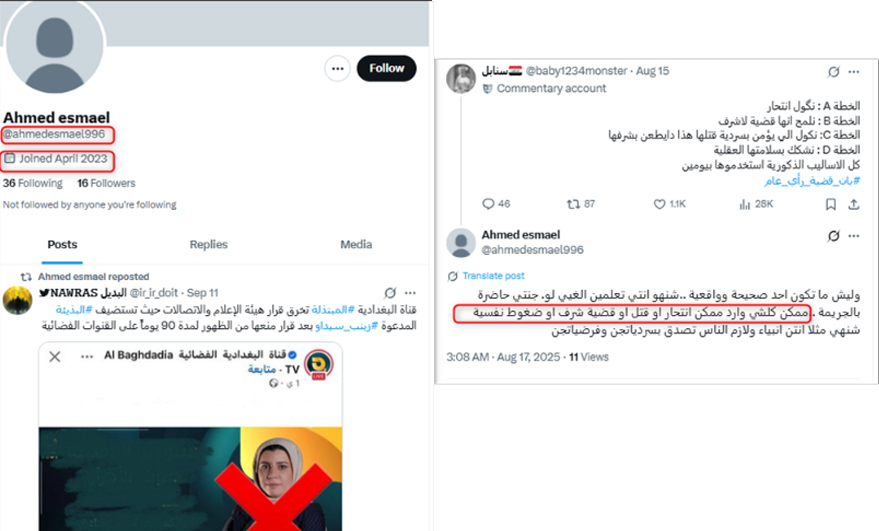
Another notable comment came from an account named "Ahmed Esmael (@ahmedesmael996)," which stated that the incident could be a suicide, the result of psychological pressure, oran honor killing. Tracing the account’s activity revealed that it is a recently created Iraqi account, established in 2023, that consistently expresses support for the Shiite political factions in power.
Central Accounts in the Campaign
Using GEPHI, we generated a network map of the accounts participating in the campaign surrounding Dr. Ban’s death. The map revealed that the networks were divided into two halves: the upper half consisted of networks that reposted or quoted from certain accounts, while the lower half represented networks that interacted through replies with specific accounts.

Although the map was divided between reposts and replies, the networks of accounts were clearly close to each other, indicating no significant division in the discussion.

One of the most prominent accounts that appeared central on the network analysis map is "Bassim Alkhazraji @AlKhazraji_75", an Iraqi journalist who introduces himself as an independent Iraqi media professional. He appears as a political analyst on Iraqi satellite channels, and his posts critique Iraq's current political situation.

An account named "Tamara Alkhazraji 🍓 @Tamarakhop" also appeared. It is a relatively new account, located in Baghdad, and describes itself as belonging to a journalist, activist, and blogger.

Another account appeared, named "Kwili | كويلي @kwtil", a Kuwaiti account that describes itself as a "story content YouTuber". This account attempted to internationalize the issue of the doctor's death by presenting the case to the United Nations Human Rights Organization.
This confirms that the publishing campaign about Dr. Ban's death is led by accounts opposing the political regime in Iraq. They adopt the narrative that she was killed in order to escalate the issue to become a public opinion case that can mobilize opposition.
Questions about the Official Narrative
Despite clear indications of a coordinated and amplified campaign surrounding Dr. Ban’s death, this does not serve as proof of the validity of the official narrative, which deemed it a suicide.
In the face of this digital momentum, which questioned the official account and attempted to gather evidence that the death was due to murder, some accounts sought to support the authorities’ discourse. Suspicions increased, especially after MP Uday Awwad Hussein published a report indicating the presence of signs of strangulation and various bruises on the deceased’s body.
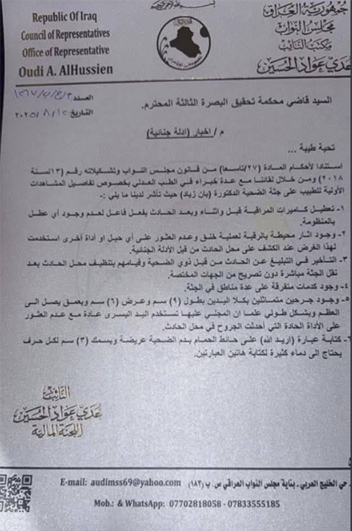
On August 18, the day the campaign's posts peaked, and the Iraqi judiciary closed the case after describing the incident as a suicide, an account called "Muqtada Al Maqdisi @meQdisii" published a video clip claiming to be "Dr. Ban's last audio recording," claiming it was as evidence of her suicide.
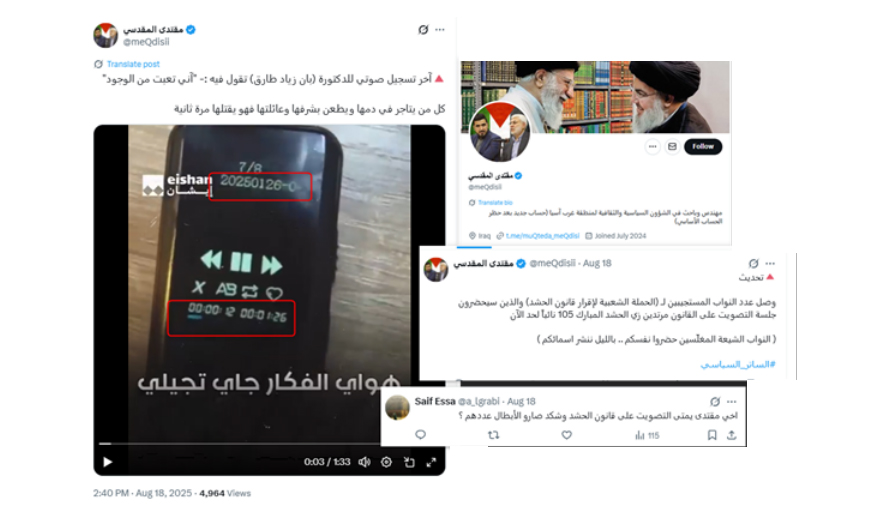
The account "Muqtada al-Maqdisi" is a pro-Popular Mobilization Forces account, publishing posts supporting the campaign to approve the "Mobilization Law" (Hash) in the Iraqi parliament. The majority of accounts supporting the narrative of the doctor's murder are anti-Popular Mobilization Forces. The most important observation in the video clip is that the date recorded on the mobile phone screen or recorder dates back to January 26, 2025, at least seven months earlier, which means it is impossible for it to be the doctor's last recording.
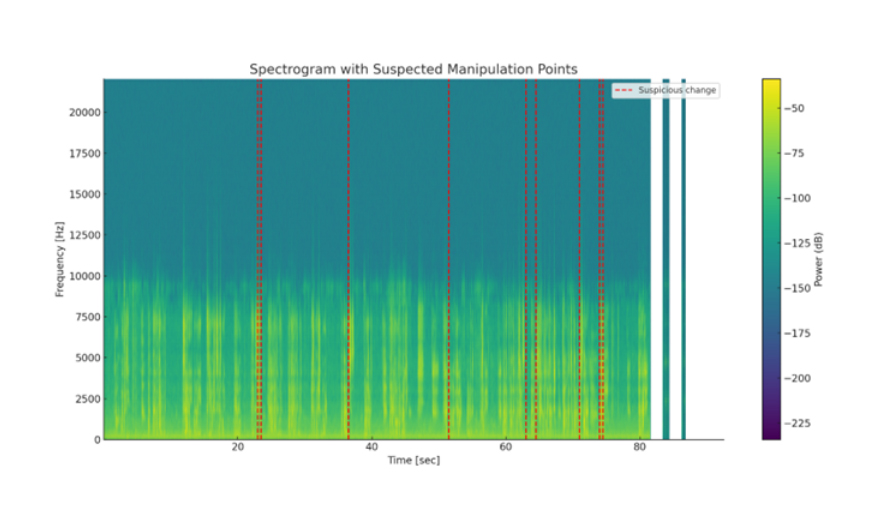
Using a specialized artificial intelligence tool, we analyzed the audio spectrum of the recording, which showed six strong spikes in energy levels—indicating a high likelihood of manipulation or cut-and-paste editing within the audio file.
In the previous image, the red lines mark abnormal jumps in audio energy or frequency spectrum levels. Notably, between seconds 71 and 75, a sequence of consecutive changes occurred, suggesting the possible removal or alteration of an entire segment of the recording.
While this analysis does not constitute definitive forensic evidence, it clearly indicates a strong suspicion of tampering with the audio file.
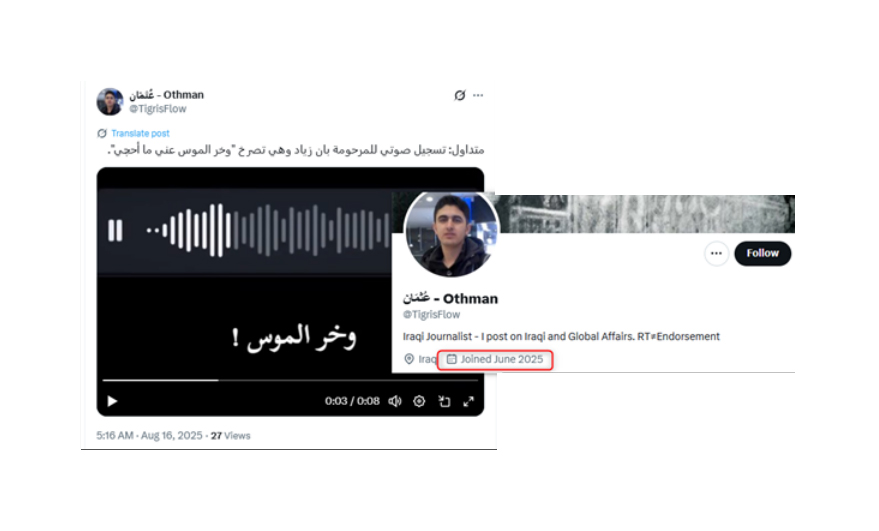
Before this clip went viral, an account named "Othman@TigrisFlow," a recently established Iraqi account, published another recorded audio clip, claiming it was "an audio recording of the late Ban Ziad screaming."
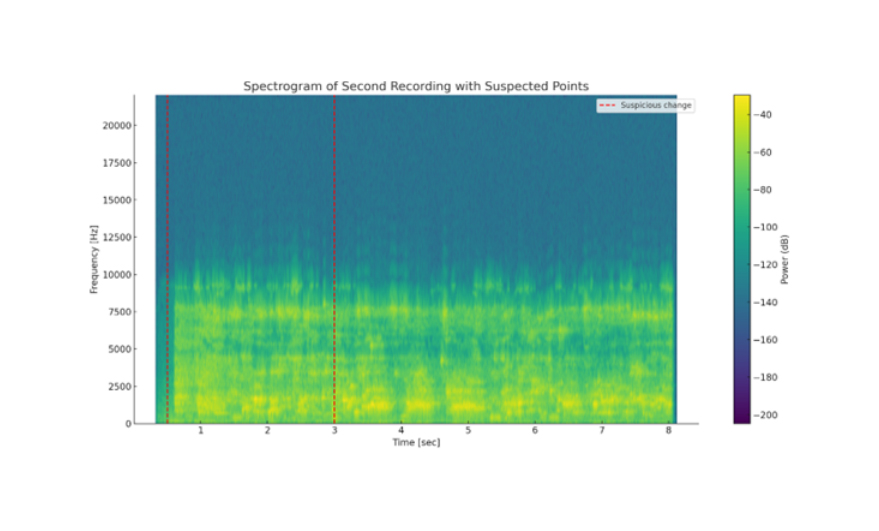
An analysis of the sound spectrum of the clip using the same model revealed that the fingerprints of the two voices in the two clips are very similar, which suggests that they belong to the same person. The model also suggested that the second audio clip does not contain significant transitions or jumps in sound energy, which indicates that it is an original recording with no noticeable manipulation, unlike the first clip.
We conclude from this that the issue of the death of the Iraqi doctor Ban revolved mostly around two conflicting narratives; the first is the official narrative stated by the family and approved by the Iraqi judiciary, which is the doctor's suicide due to psychological pressure. The second attempted to question the doctor's suicide and confirm that the death was the result of a murder.
The campaign promoting the second narrative, through social media, was led by automated accounts that worked to amplify the spread of hashtags confirming that the doctor was murdered.
In contrast, evidence and testimonies emerged indicating criminal suspicions surrounding the incident, including traces of strangulation and torture on the doctor's body, in the face of the official narrative that considered it a case of suicide.
However, it remains impossible to conclusively determine the true cause of the doctor's death based on the evidence circulating on social media platforms, especially after the possibility of evidence manipulation was revealed.
This material is published in collaboration with Jummar.


